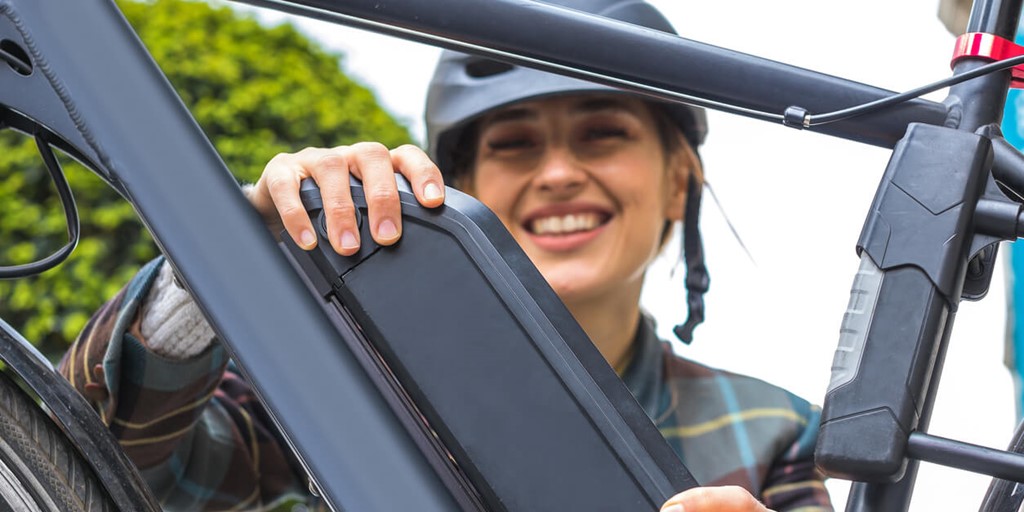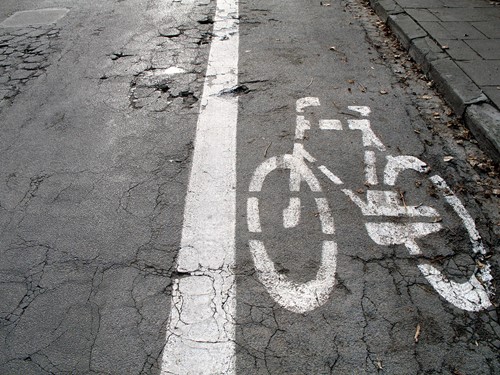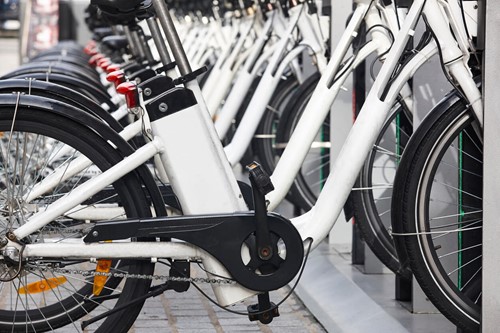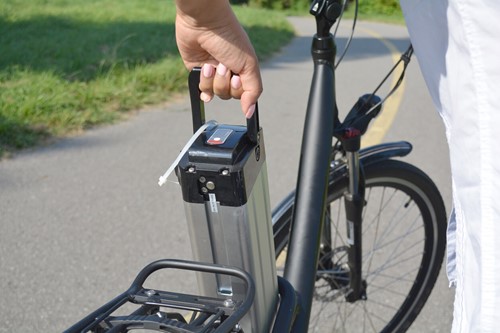E-bike battery maintenance—Richard Peace’s top 5 tips for looking after your e-bike battery

Electric bikes (e-bikes) are arguably more popular now than ever before.
Newer e-bike models on the market today are challenging the old ‘clunky’ stereotype with their improved battery life, slick design, lightweight frames and, of course, their positive environmental impact.
But, as an e-bike owner, you’ll know better than anyone they need regular TLC to keep them running smoothly—not to mention they’re a prime target for thieves thanks to their typically high price point.
Your e-bike battery is one of the bike’s most important components, and with such a title comes a certain need for extra care and maintenance.
Richard Peace knows a thing or two about e-bikes and their batteries.
Richard has been writing about e-bikes for more than thirty years as a cycling journalist and author, with work published in more than 20 cycling titles and various national media outlets. He’s also written several books, including Electric Bicycles and Cycling Northern France.
We sat down with Richard to talk all things e-bikes, but more importantly, find out his top e-bike battery maintenance tips and what you can do to look after yours.
Read on to find out what he had to say.
Table of contents
1. Avoid extreme temperatures
2. Avoid knocks and bumps in the road
3. Don’t let the battery completely drain
4. Use a manufacturer-approved charger
5. Keep the contact points clean and dry
Richard Peace’s top 5 tips for e-bike battery maintenance
In no particular order…
1. Avoid extreme temperatures

Most modern e-bike batteries are lithium-ion based, so you need to be mindful of the surrounding temperatures both when you’re out riding and when charging them.
Your e-bike battery can become damaged if temperatures get either too hot or too cold—even when not in use. In high temperatures, in particular, ventilation can become a serious problem, which can lead to battery failure and even fires in some of the worst-case scenarios.
Whether you’re charging, storing, or using the battery, here’s what’s typically considered temperature extremes.
Too hot
anything above 20˚c is too hot for e-bike battery storage
temperatures below 60˚c are generally considered fine for riding
temperatures shouldn’t exceed 45˚c when your e-bike battery is charging
Too cold
never store your e-bike battery or ride in conditions below -10˚c
temperatures shouldn’t fall below 5˚c when charging your battery
The ideal charging conditions for e-bikes tend to involve slow charging in cool temperatures (but not too cool, of course). As for discharging (when it’s in use, not charging), you should aim to maintain a standard room temperature.
Scientists have proven that slightly warmer temperatures tend to boost battery capacity, so keeping the temperature in check means you can get more range from the battery, too. On the other hand, however, battery capacity decreases the closer the temperature gets to 0˚c.
Despite the proven benefits of warmer temperatures, they can, in fact, reduce your e-bike battery’s shelf-life if left exposed for too long. So, it’s important to do your research and find a balance.
Related: Best temperatures for electric bike battery storage, usage and charging
2. Avoid knocks and bumps in the road

Just as driving on bumpy roads is bad for a car’s suspension, riding on uneven surfaces can damage your e-bike and battery.
Bumps and potholes in the road can cause your e-bike to jolt forward unpredictably, which can cause damage to the bike’s components, such as the battery.
E-bike batteries are more susceptible to overheating and cutting out when damaged, as their overall functionality becomes severely hampered. So, it’s important to check the battery regularly to look out for any signs of damage that could’ve been caused by riding on poor roads.
Knocks and bumps in the road can also damage the battery prongs or push them out of their normal alignment. If this happens, further bumps in the road will cause the battery to come loose and subsequently disconnect your power.
You should remove and replace your battery straight away if you suspect it’s damaged—leaving it in situ is simply not worth the risk in the long term.
Related: 7 tips for cycling on rough roads
3. Don’t let the battery completely drain

You should always try to avoid letting your e-bike battery completely drain down.
Suppose lithium-ion batteries (which, as we mentioned earlier, are used in most modern e-bikes) are allowed to fully discharge. In that case, their ability to later hold a charge reduces, which leads to a significant drop in battery capacity over time.
The best and simplest way to avoid this is to keep your e-bike battery charged.
Get into the habit of recharging it after every ride—even if it was only a short one. Recharging is normally advised if the battery is anywhere between 30-60% capacity, so keep an eye on the specifics if you can.
However, if your e-bike battery does ever drain completely, you should recharge it as soon as you’re able to.
That said, it’s indeed possible to overcharge your battery, and this, too, is a bad idea.
You shouldn’t leave your e-bike on charge for long periods—we’re talking for days at a time. Doing this repeatedly will, in fact, lessen the effectiveness of future charges and hence limit your e-bike’s range.
Related: 5 electric bike charging tips for long battery life
4. Use a manufacturer-approved charger

E-bike battery charging can be dangerous if not carried out properly. Although rare, batteries can ‘fail’, which can then lead to explosions and subsequent fires.
To preserve your e-bike battery’s shelf-life and ensure a problem-free charging process, you should always use a manufacturer-approved charger. Don’t be tempted by non-branded, often cheaper, alternatives online, as using these could be disastrous for you and your e-bike.
If you spot any signs of damage on your existing charger, make sure you buy an official replacement from a reputable, manufacturer-approved outlet.
However, it’s not just a case of using the correct charger—you also need to use it correctly.
We’re probably all guilty of not paying too much attention to instruction manuals, but e-bikes are an example of when it pays to read the small print.
Most e-bike chargers will come with specific instructions for use, and they must be followed. As simple as it may sound—always make sure you unplug your charger when you’ve finished using it, too.
Related: Charging e-bikes and e-scooters safely
5. Keep the contact points clean and dry

While e-bikes are totally fine to take out in the rain, you still need to be careful when it comes to water and your battery.
Though it’s unlikely you’d do this, you mustn’t ride your e-bike through water deep enough to fully submerge the battery and motor.
E-bike batteries are particularly susceptible to short-circuiting if underwater for a long time—and trust us, you don’t want that to happen while out on a ride.
It’s wise to give your e-bike a quick clean and wipe-down after a rainy ride. It’ll only take you a few minutes but will be worthwhile in the long term.
Wiping down and assessing the condition of your e-bike allows you to spot any damage but also the state of your battery’s main contact points. These must be kept as clean and dry as possible.
If you suspect that water has got into the battery contact points, one useful hack is to use a hairdryer to disperse the water once you’ve taken the battery out.
The battery should be left out for a few hours, too, to let it completely dry out. You can also buy plastic caps for the battery contact points if you want to take extra weather precautions.
If the contact points are dirty, take out the battery, wipe it down with a soft cloth and spray contact cleaner onto the surface.
Related: E-bikes and the rain: 5 do’s and don’ts
Many thanks to Richard for sharing his e-bike battery expertise!
Richard can be found on Twitter at @richardpeace6. You can also visit his website for more information.
How do you ensure your e-bike battery maintenance is kept in check? Let us know.
You can be as careful as can be with your e-bike, but the sad reality is that accidents can happen. That’s why you also need to make sure you have the right insurance in place.
At Cycleplan, our specialist electric bike insurance protects your e-bike against loss, theft and accidental damage up to the value of £30,000, so you can ride with complete peace of mind.
We also offer Public Liability up to £5m and protection against personal injuries. Not only that—our policies are also underpinned by our very own ‘Ripe Guarantee’, which means you won’t find the same level of electric bike cover for the same price anywhere else on the market.
Click here to learn more about our specialist electric bike insurance and get an instant online quote today.
Related
How to protect your e-bike in 6 easy steps
The 8 best e-bikes in the UK in 2022
What to wear for cycling in spring 2022






